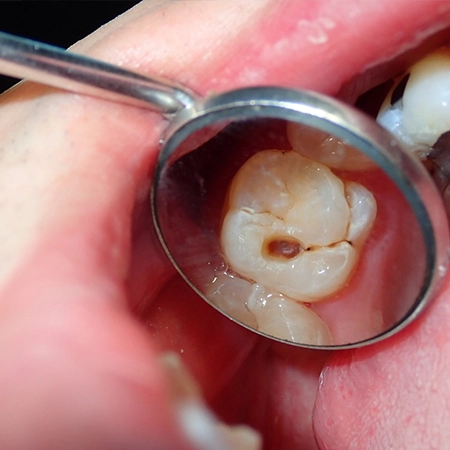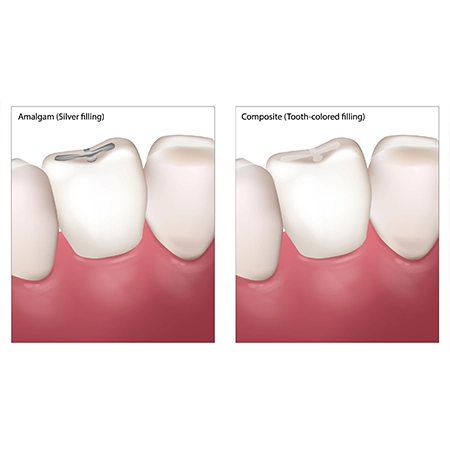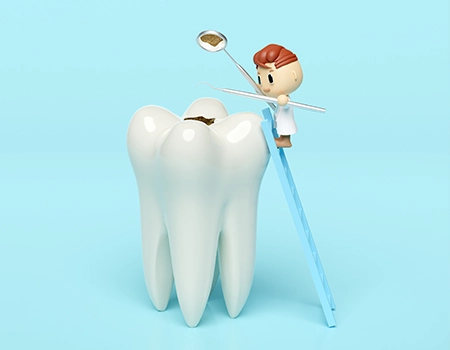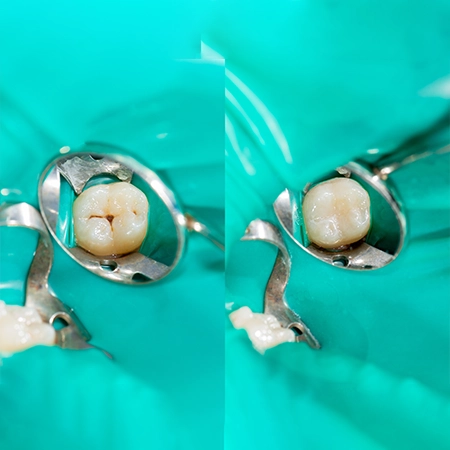Dental Fillings In Aurora, IL
Dental fillings
Tooth decay, or cavities, is one of the most common dental issues faced by patients all around the world. They are usually due to a variety of factors including your diet and lifestyle habits, oral hygiene habits, access to quality dental care, and more.
City of Lights Dental in Aurora recommends regular dental check-ups and proper oral hygiene practices to detect and treat oral health issues early. Dental fillings are typically used to treat tooth decay.

Why Choose City of Lights Dental for Dental Fillings In Aurora?
The dental professionals at City of Lights Dental are proud to provide exceptional dental care to the residents of Aurora and the surrounding areas. There are several reasons that you should choose City of Lights for your dental needs, including:
- Our dental professionals are highly skilled and experienced- and truly compassionate
- We have state-of-the-art equipment and facilities to provide the most precise and comfortable treatments
- Your dental team will work with you to create a personalized treatment plan to meet your personal needs, expectations, and budget
- We are committed to your safety, comfort, and overall well-being during the process
The team at City of Lights Dental understands that dental care can be intimidating- but we always work hard to create a pleasant, stress-free experience every time you visit us.
Significance of Dental Fillings in Oral Heath
Dental fillings are used to treat tooth decay, preventing it from spreading. This treatment plays a significant role in maintaining your oral health. When cavities are filled, the strength and integrity of the teeth are restored, the risk of further damage is reduced, and your beautiful smile is preserved.

Average Cost of Dental Fillings
The average cost of dental fillings varies based on several different factors, including filling material, location of dental practice, size of the decay, and dental insurance. The average costs are:
Silver Amalgam Fillings
Typically, silver amalgam is the most affordable, with an average cost of $50 to $150 per filling.
Composite Fillings
Composite fillings, also known as tooth-colored fillings, typically cost more than silver amalgam, with an average cost of $90 to $250+ per filling.
Ceramic Fillings
Ceramic fillings, or inlays/onlays, are typically the most expensive with an average cost of $250 to $1,000 per filling- depending on the complexity of the procedure.
These cost ranges are average estimates and can vary significantly based on the location of the clinic, the experience/expertise of the dentist, the size of the decay, and the materials used. Dental insurance often covers a portion of this treatment. Our office staff will work with your provider to determine your coverage.
If you do not have dental insurance, we do offer dental financing to help you get the treatment that you need to restore the appearance and functionality of your teeth.

Types of Dental Fillings
There are several different types of dental fillings, including:
Silver Amalgam
Silver amalgam fillings are made of a combination of metals including mercury, silver, copper, and tin. They are extremely durable and often used to restore molars and premolars. In addition, this type of filling is more cost-effective. However, they have a silver/gray color, which makes them less aesthetically pleasing.
Composite
Composite fillings are made of a blend of tooth-colored plastic resin and fine glass particles. Since they can be matched to your natural tooth color, they are aesthetically pleasing and can be used on front and back teeth. They bond directly to the natural tooth and are durable.
Ceramic
Ceramic, or porcelain, fillings are also referred to as inlays or onlays. They are made in a dental lab based on digital and physical impressions taken of the tooth. They can be matched to neighboring teeth, so they can be used on front and back teeth. Finally, they are known for their strength and durability.
We will discuss your options during your consultation visit to help you choose the best option based on your needs, expectations, insurance coverage, and budget.
Who is the right candidate for dental fillings in Aurora?
Dental fillings are recommended for patients who have one or more teeth that have been impacted by tooth decay or damage. The dental team at City of Lights Dental will examine your mouth to determine your candidacy for this procedure. As a general rule, the following factors are considered:
- Tooth decay: this is the most common reason to get a filling. A cavity creates a hole/pit in the tooth enamel. A dental filling is used to fill the hole and restore the structure of the tooth.
- Damaged tooth: a dental filling can be used to repair and protect a tooth that has been fractured, chipped, or cracked
- Worn teeth: dental fillings can restore the shape and function of teeth that have been worn down due to bruxism, erosion, or other issues
- Decayed/damaged fillings: in some cases, an existing filling may loosen or become damaged and needs to be replaced
- Aesthetic concerns: in some cases, a dental filling may be used to restore the appearance of a tooth that has minor discoloration or imperfection.
- Preventive: in some cases, sealants may be recommended- especially in children and teens- on the chewing surfaces of teeth to protect them from tooth decay


Benefits of Dental Fillings
There are several benefits of dental fillings, including:
- Restores the health and function of your teeth
- Prevents the spread of tooth decay
- Improves the appearance of your smile
- Maintains overall oral health
Dental Filling Procedure
Dental fillings are used to repair teeth with tooth decay or minor damage. The procedure is fairly straightforward. Here’s what you can expect:
- Exam and diagnosis: The first step is the examination and diagnosis
- Choosing the dental filling material: The dentist will explain the dental filling material options and help you decide which one is best for your needs and expectations
- Anesthesia: Once the dentist has located the decay, anesthesia will be applied to numb the tooth and the surrounding area to ensure that you are comfortable during the procedure
- Decay removal: A drill/laser will be used to remove the decay/damage to ensure the tooth is prepared for the filling material
- Tooth prep: Once the decay is removed, the dentist will then clean and disinfect the area. Then, the tooth will be shaped to create space for the filling material
- Placing the filling material: The filling material will be placed into the prepared tooth based on the type of material used.
- Shaping/polishing: Once the filling material has been placed, the dentist will shape and polish it to ensure that it blends with your natural tooth structure
- Bite check: Finally, the dentist will check your bite to ensure that they align properly
Typically, the procedure takes an hour or less and can be completed in a single appointment. Once the anesthesia wears off, you can resume your normal activities.

Aftercare and Recovery
Following the procedure, you will have some residual numbness from the anesthesia- which should wear off within a few hours. While it’s fine to eat after getting a dental filling it’s best to wait until the anesthesia wears off. Otherwise, you may bite your cheek, lip, or tongue.
If you have some sensitivity, you may want to stick with soft foods until the sensitivity resolves itself. If you were given prescription medications, make sure to take those as directed.
If you are still experiencing discomfort and sensitivity after a week, it’s important to contact the dentist for an evaluation. Regular dental hygiene, including dental visits, can help with maintaining your dental filling.
Do You Need a Dental Filling? Schedule Your Consultation Today
If you believe that you may benefit from a dental filling, schedule your consultation with the team at City of Lights Dental today in Aurora, IL. We offer a wide range of dental services including general, cosmetic, and restorative procedures for patients in Aurora and the surrounding areas.
We start with an examination and discussion of your needs and your expectations to create a custom treatment plan to help you get the perfect smile you’ve always wanted.
Dental Fillings FAQs
If you have any questions or concerns, the professionals at City of Lights Dental can address them at any time. Below is a sampling of some of the most common questions that we’ve been asked about dental fillings:
How long do dental fillings last?
The average lifespan of a dental filling depends primarily on the material used and your oral hygiene and lifestyle habits.
On average, amalgam fillings last up to 15 years and composite and ceramic fillings last an average of 7 to 10 years with proper care and maintenance.
Is it painful to do tooth filling?
Local anesthesia is administered before the procedure to mitigate pain and help patients relax. This makes the procedure itself virtually pain-free. If necessary, sedation may also be offered. Some patients experience post-procedure sensitivity- but this is typically temporary.
Which type of dental filling is better?
There are several different types of dental filling material available including amalgam, composite, and porcelain. The best one depends on your specific needs, expectations, and budget. We will work with you to discuss these aspects and help you determine the best option based on your personal preferences and oral health.
Which is better, root canal treatment or a filling?
The choice depends on the severity of the issue. If possible, a dental filling is best- which is why regular check-ups are critical. However, if an infection advances into the dental pulp, root canal treatment may be necessary.
Can I eat after a filling?
Yes, you can eat after getting a dental filling. However, it is recommended that you wait until the anesthesia wears off. Also, don’t use a straw and, if you experience sensitivity, avoid foods/beverages that are extremely hot or cold.

